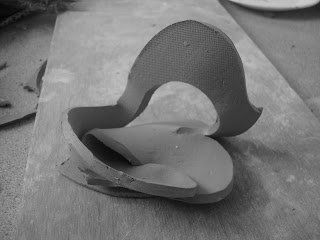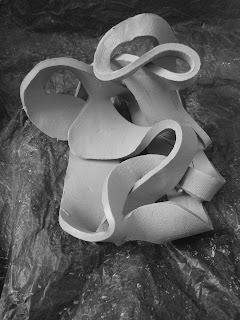Followers
Tuesday, May 15, 2012
2nd Year Personal Research
Project
You must think about the processes
that you were introduced to through the workshops this year (Decorative, Glaze,
Plaster, etc.). Select a maker whose work you admire who applies a selected
range of these processes.
Introduce us briefly to their work
and their concepts, but the main focus of your Research and presentation should
be on the technical aspects of Materials and Processes.
Delivery: You must put together a 4
slide illustrated Powerpoint Presentation to present your research verbally to
your peers. Those attending should be left with a clear understanding of the
techniques as applied by that particular maker and how the effects can be
achieved if they were to apply the techniques to their own work.
You must also present some practical
samples that you have made as part of your research project (test tiles or
other, related to the content) that add further understanding for your peers.
Eva Hild is a ceramic
artist she is part of the new generation of Swedish art craft and design makers
exploring the boundaries between art, craft and design.
A graduate of Göteborg
University's School of Design and Crafts, Sweden, Eva Hild has exhibited widely
and is represented in important private and public collections.

Building her large scale sculpture pieces
using coils of clay, it takes weeks for her to coil and scrape her sculptures Hild's sculptures grow slowly, contemplatively, and the work
cannot be hurried along. She soothes out the seams and rounds off the forms
using a metal scraper the clay is smooth, malleable and
leathery which enables her to produce complex forms
Through hand-building,
Hild gradually builds up her sculptures, change the direction
and make the shape as a hole connect, making the forms veer off into loop, twist and billow in one direction or another while having smooth surfaces all with the same thickness.
and make the shape as a hole connect, making the forms veer off into loop, twist and billow in one direction or another while having smooth surfaces all with the same thickness.
Her material is white
porcelain clay that includes graded molochite grogs to ensure low shrinkage
during firing also this grade of clay does not readily collapse it can be used
to make large forms
When the clay is quite
dry she spends hours in a fume-cup-board, sanding away at the surfaces.
The sculpture pieces
are allowed to dry slowly and are finally fired twice at stoneware temperature
1230o -1250o degrees Celsius for up to 48 hours and finally treated with white
silicate slurry of kaolin which forms a white colour coating. Her kiln sets the
limit to the size of her work. Each piece takes from two to three months of
work.
"Influence,
pressure, strain these words have been the foundation for my current projects
that comprise communicating the theme in large, hand-built clay forms.”
Footnote
1
“People
have always been fascinated by the relationship between the interior and
exterior worlds: the dualism between inside and outside, content and form,
feeling and shape, impression and expression, explanations and religious
concepts.” Footnote 2
Given the complexity of
Hild's forms one might imagine that she would use a
computer to calculate them. This is not the case, she makes a few sketches in
advance but the details cannot really be foreseen. Eva Hild's way of working involves endless patience and all the
skills of her craft. Her complex forms cannot be cast or rolled out this is why
she uses clay for its plastistae allowing itself to be constantly reworked.
Without this use of
computer and mathematical calculation Eva’s forms have a timeless quality about
them as though they had come about through natural processes. These
are also a complex yet continuous flows of reverberating line create organic
associations without looking like any specific thin. The absence of colour and
the perfection of surfaces keep Eva’s sculptural forms firmly in the area of abstraction.
“Eva Hild
achieves a unity of inside and outside, starting from the inside and employing
not the basic geometric forms but organic forms from the natural world. Most
important of all is the air that fills the cavities the emptiness. What she is
trying to do is to visualise something that cannot actually be seen.”
Footnote
3
As the viewer’s gaze
follows the winding cavities, the shadows and surfaces seem gradually to change
form. They reflect varying degrees of external and internal pressures. What
makes Hild's forms beautiful for me is there is no concentrate on any
particular part there is no focus point. Her Sculptures have no front no best
pictorial viewpoint her works convey flowing movement.
Eva’s works shows
context of her minimalist Scandinavian living, with her shear white/black
surfaces also there is a feminine curvature gracefulness within her
work.
“Eva has found a personal, wordless
language in which to express feelings, whether she is communicating a whisper,
pain or joy. And those of us who behold her work are reminded of how our own
inner emptiness feels.”
Here is my responance to 2nd Year Personal Research Project
1st working in paper then translate the same format into clay.

Clay work rolling out slabs then cuting into it.
‘Historical
Object’. Yr 2 - Semester 4
8
Weeek Brief. January 9th –
March 5th 2012.
You must ensure that you cover and clearly evidence the following 4
stages over the 8 weeks and reach a conclusion by the end of the 8 weeks to
satisfy the Aims and Outcomes.
·
Research
·
Development
·
Materials & Processes
·
Resolution/Declaration.
You will be given a link to 2 Historical objects – after
a quick analysis you must choose one to work from (forget
the other).
Be objective in your
research and analysis.
Research and
analyse your object. How does it inform you?
·
What is it?
·
Does it have a function or functions? In its own time? Now?
·
Can you find out anything about the Materials
and Processes?
·
What period is it from?
·
Social History…who would have owned it? What
status would the object have had? What did it say about the owners?
·
Does it carry a message?
·
Is there a narrative?
·
Other?
Each point should be responded to in a considered way. You
should be forming opinions, and from this process begin to develop a sense of
which aspects you find particularly interesting and would like to put a
particular focus on. Remember you are working in a visual field – respond to
the above questions in visual form (2D Drawing/Sketchbook).
Having done this part of the research you are
required to explore your object in 3D, Work
in paper, wire, with photocopies, take photographs, illustrate, build,
manipulate, work in Photoshop, print, draw, explore the graphics – drawing
particular attention to selected aspects of personal interest from your
analysis. You are drawing form a source object that informs us from the past,
responding to it as a contemporary maker. Your position is not to replicate,
but to extract information that is of interest to you. Apply the creative process to generate an
object that is your response to the above
research and analysis with sensitivity to the materials and
processes you choose. Apply the original list of questions to your new object,
defining what it is, its function, its context.
With this information/3D Source you must now develop your
object in clay applying the same consideration for sensitivity to Materials and
Processes. Remember the Workshop processes and the stages at which they are
applied and the possibilities offered by accumulative processes.
General Aims - Year
2 Semester 4
·
To develop appropriate standards in the design
and production of ceramics for this stage of the Course.
·
To develop problem solving abilities through
research and analysis.
·
To identify personal ceramic practice within a
broader historical and contemporary context.
·
To increasingly develop a maturity,
self-confidence and critical judgment in relation to their work.
·
To develop self-reliance and commitment through
establishing professional work practices within the course.
General Learning Outcomes
With the realization of the above aims, learners should be able to:-
·
Produce ceramic work using materials and
processes appropriate to the realisation of creative solutions, and demonstrating
skill levels appropriate for this stage of the Course.
·
Exhibit increasing understanding of the
methodologies and strategies required for the development of problem solving
skills through research analysis, critical thinking and the effective communication
of ideas.
·
To understand personal Ceramic practice within a
broader historical and contemporary context.
·
Exhibit increasing critical judgment in relation
to their own work and demonstrate a developing creative personality through the
medium of ceramics.
·
Understand and apply professional standards in
production processes and workshop practices.
Stemcup with sea creatures
From Jingdezhen, Jiangxi province, southern China
Ming dynasty, Xuande period (AD 1426-35)
Ming dynasty, Xuande period (AD 1426-35)
Dragons and other creatures frolicking in the waves
The short reign of Emperor Xuande (1426-35) was very significant for Chinese ceramics: copper red wares reached heights which have never been surpassed, whileStem cups like this were used in Buddhist ceremonies and as wine bowls. This example shows dragons and other sea creatures playing among the waves. The sea creatures were reserved, that is, the background was painted with blue, and the area with the creatures was left white. The piece was then glazed and fired in the usual way. This is a relatively simple but very effective technique.
The regular use of the emperor's reign mark denoted a new status for ceramics. This first appeared, though rarely, under the Yongle emperor (reigned 1403-24). The mark on this cup is centred on the inside of the bowl.
Subscribe to:
Posts (Atom)



























































